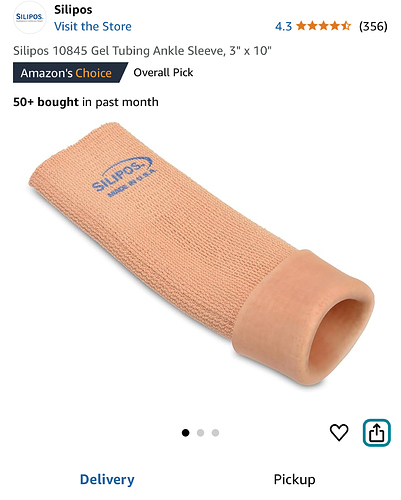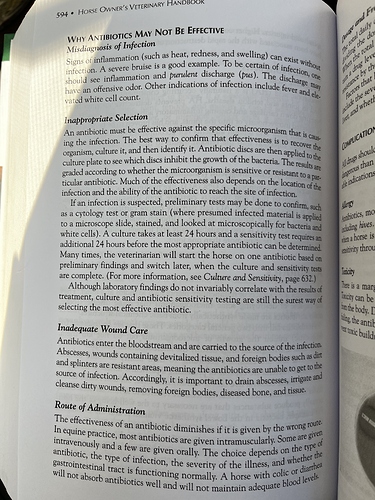we never even got an infection pocket to show up, the x-rays are super clean which is good but not for diagnosing whatever situation is going on. Did the abscess just seal up and he was sound and fine one day? What treatment did you do for it, did you continue soaking or wrapping etc?
That’s true, I could see what just a phone consult of something like that would be, sharing pics and X-rays, and go from there, thank you I hadn’t thought of that option and certainly less immediate financial outlay (not that he isn’t worth every penny of course)
that’s super interesting, I also would say that he does seem more comfortable on it when it is open he will rest his weight on the left hind rather than keeping his weight off it as he does when he is more uncomfortable, the thing that gets me is how this initially (in Sept) seemed to present as a “standard” hoof abscess, but he went on SMZs and then about 3-5 days to a week after the SMZs were over he was almost 3 legged and the leg was swollen + fever, but I wonder if the antibiotics he was on (he went on 3 or 4 rounds all told in the past 3 months each about 10-14 days) kind of messed up his symptoms and how his body dealt with whatever was going on and skewed the clinical picture a bit if that’s possible. I wonder if he might have had something go in, maybe a small puncture I didn’t see, and it resulted in necrosis of some tissue in there and that has been what the body is trying to expel, pure speculation. Do you (or anyone obviously) know if/how necrotic tissue shows up on an x-ray?
We did a lot of ultrasounds as opposed to x-ray given the location of the abscess, no obvious foreign body was ever identified via that imaging. The decision to debride was kind of more an exploratory approach given the abscess wasn’t resolving on its own.
The whole event was probably a couple of months, starting with an apparent capped hock (no obvious external injury), then increased swelling that we feared was a tendon sheath infection. He went to the hospital at that point for intensive imaging and they didn’t find the tendon sheath involved. Was on various antibiotics until the abscess showed externally and popped, and then closed and opened multiple times. He was flat-footed when it was in the draining stages because of the release of pressure, and then would go toe touching when it closed over. Continued trying different antibiotics when it wasn’t resolving. He actually lived at my vets clinic for more than a month to managed the risk on his weight-bearing leg. I did have to advocate for more aggressive treatment at the hospital in the end because what we’d been doing just wasn’t working.
I’ll also say that going for the debridement was the cheaper option in the end. I was spending a lot of money on antibiotics and extra care. Debridement was an outpatient procedure and after the first bandage change a day later to remove the packing, he went back to his boarding barn and I did the remaining bandaging until the incision closed. He was also immediately comfortable standing on the leg again.
@Foxglove how much wrapping, poultice, etc did you do for the abscesses? How much swelling did you see above the coronet band?
Helpful thread as I have a similar saga going on now as well…
this is super helpful, thank you, my boy does not appear as sore as yours was when it seals over, which I am thankful for, but he also is a very stoic guy so when he is exhibiting pain and discomfort even at lower levels its often worse than he lets on
was the debridement option the surgical one where they cut out the tissue or did you go for a different debriefing procedure?
I think technically it was a surgical debridement. They basically opened the abscess with a scalpel and then pulled out the dead tissue with forceps. They came out afterwards with a test tube with the small bit of dead tissue in it and showed it to me afterwards.
I have pictures from every week of the progress for the six months from start to complete grow-out. That’s a lot of pictures! Let me know if you want a specific stage . . .
Vet and farrier had me start with the classic soak and antibiotics.
After the coronet band opened, it was recommended to stop soaking as the water might carry bacteria into the hoof via the open wound.
All this started in January, so quickly mud became an issue.
What we did continue was daily, twice a day, hosing for 10 min and antibiotics.
When the coronet band continued to open into sequential wounds growing down the hoof, at that point I was told to put ICHTAMMOL drawing salve into the wound, stuff cotton into the cavity, then vet-wrap, followed by duct tape, and then a hoof boot (I happened to have Old Mac Boots).
The bandaging was only for the last month or so --then spring came and everything sort of resolved. The horse did lose about 1/4 of his hoof (just fell off) on the outside --shoer said not a big deal since horse goes barefoot anyway.
The hoof grew back --it took about 6 months before the last of the abscess was completely gone. The last bit was a pink spot on the sole of the hoof --but even that is gone now.
For your wrapping, might something like this be of interest?
I’ve never tried them but have always liked the idea of them.
In my experience the foreign objects in an abscess have come out on the compress pad as the wet heat draws out the pus. These were unwrapped wounds, so I wouldn’t be concerned about a wrap preventing a foreign object being expelled.
If the wound is closing over with a scab, it’s not draining anyway. If it’s staying open, I’d be concerned about new infection from dirt and debris given the location.
Clearing out the infection and reducing swelling can allow the hole to open enough that a foreign object could be flushed out.
Hoof abscesses that come through the coronet are fighting gravity when it comes to draining. A drawing poultice can really help.
which antibiotics were you given, do you remember? I am hesitant to put a drawing salve on the wound as when it is open it might irritate it and introduce bacteria into the wound
oh those look cool, I figured equifit because they look a bit softer and I need it to go around the coronet band and sit a bit lower bit this probably have better grip aka staying power
I have the Equifit gel socks. Initially got them because bell boots rubbed my horse badly in just a short ride at first until I found a kind he could tolerate. (That was a new one!). He recently sliced his hind pastern by interfering with a tiny hoof crack on the other foot. It appeared to go all the way through the skin, and since he seems to be prone to infection for things like that, I cleaned it and covered it for a few days straight with the sock. Due to circumference of the hind leg, it tended to droop down off the fetlock, but it stayed anchored to the hoof and kept the wound covered until we got to a point where I thought some Equiderma zinc paste would be good enough. Due to the gel material, it did make his coronet band a bit soft. And after a few days and one ride in the sock, it got pretty beat up. But the cut healed fine.
I’m not sure if the silver socks would grip as well as the gel ones, but I’d say it’s worth a try for either of those if you don’t want to wrap the foot too much. You might also look into something like the Incrediwear or catago hoof socks which may be a little more durable/easier to wash/and a little looser for fitting another bandage or poultice underneath. I have a pair of these as well just wasn’t willing to potentially sacrifice them for this one wound issue.
SMZs aren’t that effective for a lot of things anymore, which is why his symptoms may have gotten worse on them before you switched antibiotics. Any leg thing I’ve tried to treat with SMZs in recent years has not worked and we’ve had to switch to something else like Excede.
I wonder if sugardine might be a good idea? Sugar & betadine mixed into a thick goo.
I have the Equifit silversox and like them. They don’t have any compression at all in my opinion - they are just like a regular sock. If you want to keep them over the coronet band, they are great because you can just use some elasticon to keep them taped to the hoof. They will stay up on their own - no need to tape at the top in my experience.
If you decide to try them, get the long version that you can cut to the length that you want. They will fray eventually, but it’s a much better deal.
Are the gel socks just these? I wonder about the sizing though. The human equifit gel bands appear identical to these.
Picture from link so it looks less sketchy.
A horse at my barn had something similar-- including temperature and huge swollen leg. He had a corn stalk staub go into his hoof and up into his leg. They didn’t know that initially, of course. Because of the material it won’t show on an x-ray. I would be concerned that there’s something in the hoof at this point given the severity of the initial presentation. That doesn’t sound like a traditional abscess-- and I just had a long abscess that went on for 3 months and contemplated whether to get an MRI. But he never had any swelling in the leg or other symptoms of something potentially indicative of something more advanced than “just an abscess.”
This is great feedback, thank you!
The antibiotic use is something that I do have questions about, I got myself a new vet handbook thing, I figured a lot of the med/drug info from my copy from the 70-80s was a bit outdated but this is the section on antibiotics I found interesting especially the bit under inadequate wound care where it mentions events where antibiotics would be useless essentially which is highly applicable for my situation. Does anyone know why vets its seems across the board actually prescribe antibiotics for abscesses or assumed abscesses? I have also heard they delay healing without actually being able to help the issue in the event of an abscess but I wasn’t really aware of this before
this is the book its from btw and I highly recommend it


